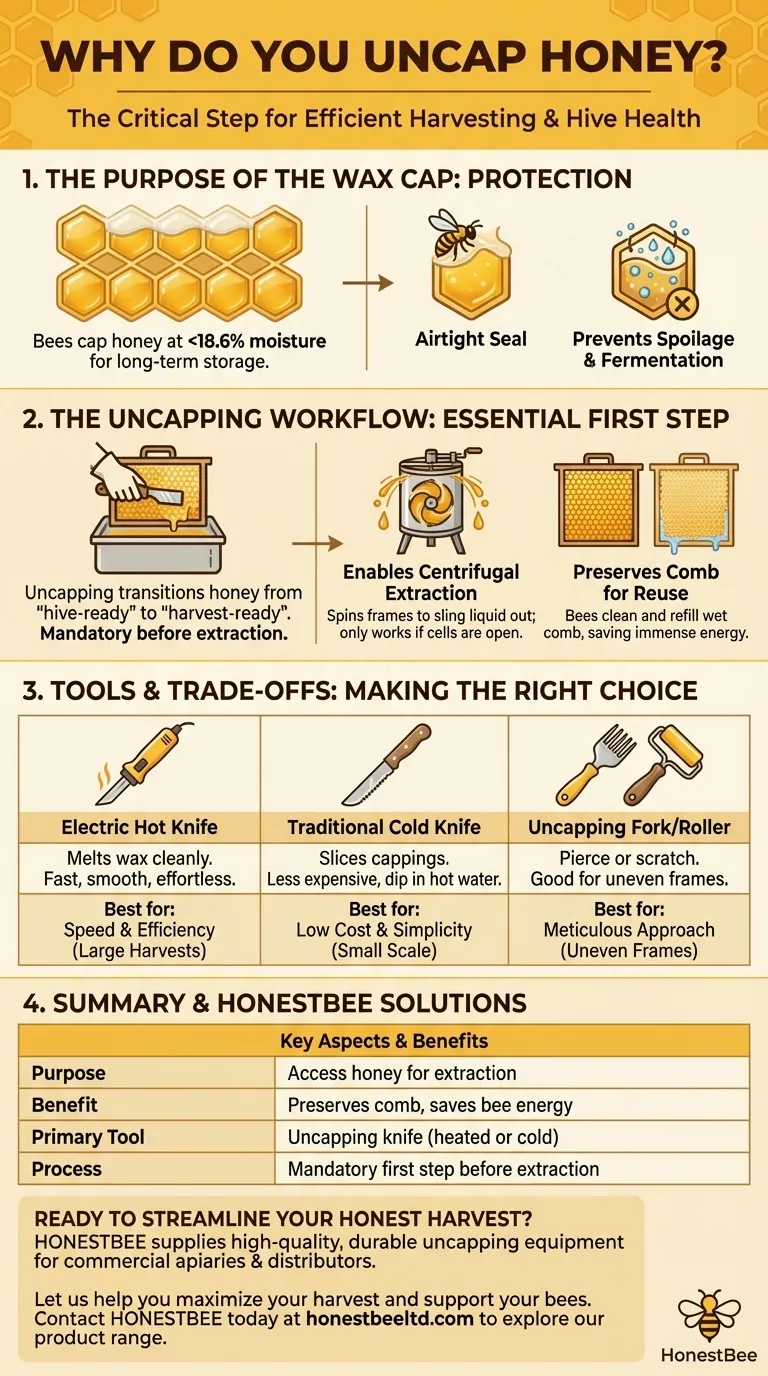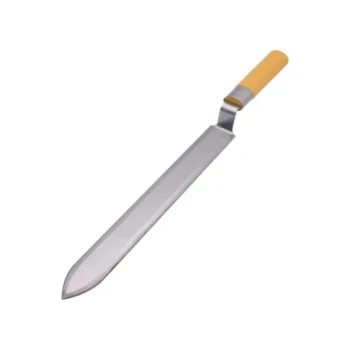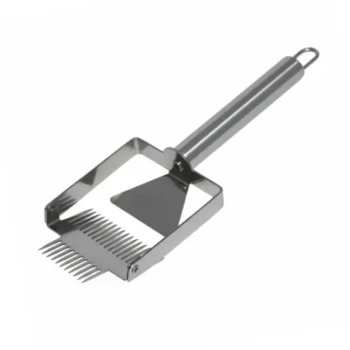To harvest honey, you must first uncap the honeycomb. This process involves carefully removing the protective beeswax layer that bees create to seal each cell, which is the essential first step to extracting the liquid honey stored inside. Uncapping prepares the frame for extraction while keeping the underlying comb intact for the bees to reuse.
Uncapping is the critical step that unlocks honey for extraction while preserving the delicate comb structure. This allows the beekeeper to harvest efficiently and enables the bees to reuse the comb, saving them immense energy.

The Purpose of the Wax Cap
How Bees Protect Their Honey
Bees cap honey-filled cells with a thin wax lid once the honey has reached the optimal moisture content, which is typically below 18.6%.
This airtight seal is crucial for long-term storage. It protects the honey from absorbing excess humidity from the air, which would otherwise cause it to ferment and spoil.
Why This Cap Must Be Removed
For the beekeeper, this perfect, protective cap is a barrier. The honey is physically locked inside the hexagonal cells.
The honey cannot be removed from the comb until this wax seal is methodically broken, scratched, or sliced away.
Uncapping in the Honey Extraction Workflow
The First Step in Harvesting
Uncapping is the mandatory first step in the honey house. It is the action that transitions the honey from being "hive-storage-ready" to "harvest-ready."
No honey can be collected from a frame until it has been properly uncapped.
Enabling Centrifugal Extraction
Most modern beekeepers use a centrifugal extractor to harvest honey. This device spins the frames at high speed, using physics to sling the liquid honey out of the cells.
This process only works if the cells are open. Without uncapping, the centrifugal force is useless, and the honey remains securely locked in the comb.
Preserving the Comb for Reuse
Careful uncapping removes just the wax lids while leaving the underlying honeycomb structure intact.
This is incredibly beneficial. The empty "wet" comb can be returned to the hive for the bees to clean and refill, saving them the significant energy and resources required to build new wax comb from scratch.
Understanding the Tools and Trade-offs
Heated vs. Unheated Knives
An electric hot knife contains a heating element that melts cleanly through the wax cappings. This makes the process fast, smooth, and effortless, especially for large harvests.
A cold uncapping knife is a less expensive, traditional alternative. These sharp, often serrated, knives are used to slice the cappings off and work more easily when periodically dipped in hot water.
Other Uncapping Methods
Besides knives, beekeepers may use specialized tools like an uncapping fork or roller. These are used to pierce or scratch the cappings, which can be useful for frames that are not evenly filled.
The Goal: A Clean Removal
Regardless of the tool, the objective is to remove only the thin layer of wax covering the cells.
A clean, efficient removal preserves the structural integrity of the comb, making extraction easier and ensuring the frame is in good condition to be returned to the bees.
Making the Right Choice for Your Goal
Choosing the right uncapping tool depends on the scale of your operation, your budget, and your personal preference.
- If your primary focus is speed and efficiency: An electric hot knife is the best tool for processing a large number of frames with minimal effort.
- If your primary focus is low cost and simplicity: A traditional cold knife is an effective and budget-friendly choice for smaller-scale harvesting.
- If your primary focus is maximizing comb preservation on uneven frames: An uncapping fork or roller allows for a more meticulous approach, opening each cell individually.
Mastering the art of uncapping ensures a successful harvest and supports the long-term health and productivity of your hive.
Summary Table:
| Key Aspect | Why It Matters |
|---|---|
| Purpose | Removes the beeswax seal to access honey for extraction. |
| Benefit | Preserves the honeycomb structure so bees can reuse it, saving them energy. |
| Primary Tool | Uncapping knife (heated or cold) is the standard for clean, efficient removal. |
| Process | The mandatory first step before honey can be spun out in an extractor. |
Ready to streamline your honey harvest?
For commercial apiaries and beekeeping equipment distributors, the right tools are key to efficiency and hive health. HONESTBEE supplies high-quality, durable uncapping equipment and other essential beekeeping supplies through our wholesale-focused operations.
Let us help you maximize your harvest and support your bees. Contact HONESTBEE today to discuss your needs and explore our product range.
Visual Guide

Related Products
- Stainless Steel Pivoting Honey Uncapping Fork with Plastic Handle
- Stainless Steel Dual Blade Uncapping Plane
- Professional Compact Multi-Function Uncapping Knife for Beekeeping
- Professional Stainless Steel Double-Sided Honey Uncapping Knife
- All Stainless Steel Double Sided Pivoting Honey Uncapping Fork
People Also Ask
- What is the recommended practice when using plain knives for uncapping? Master the Two-Knife Method for a Perfect Harvest
- What are the advantages of an uncapping fork? Achieve Precision Honey Harvesting for Your Apiary
- What is the best way to uncap honey? Find the Perfect Tool for Your Hives
- What is the primary use of an uncapping fork in beekeeping? A Guide to Precision Honey Harvesting
- What are the common methods used by small-scale beekeepers to uncap honey frames?



















